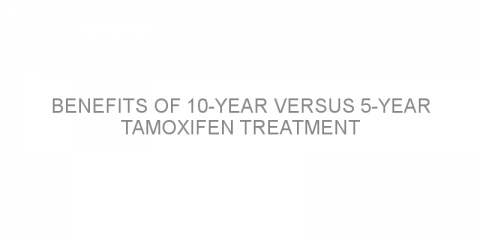In a nutshell This study compared the benefits of radiotherapy and tamoxifen in reducing the risk of local recurrence (return of the cancer close to initial place of origin) in patients with early breast cancer who underwent breast conserving surgery (BCS). Some background Women with early breast cancer usually have tumors that are confined...
Read MoreHormone receptor status-Positive (ER and/or PR) Posts on Medivizor
The effects of goserelin combined with tamoxifen on hormone levels and endometium thickness
In a nutshell This study investigated the combined treatment of tamoxifen (nolvadex) and goserelin (zoladex) in women diagnosed with early stage hormone receptor positive breast cancer. Some background Growth of hormone receptor positive (HR+) breast cancer is stimulated by the hormone estrogen. Tamoxifen is an oral drug commonly used to treat HR+...
Read MoreComparing genetic tests for predicting risk of cancer recurrence in breast cancer patients
In a nutshell This study assessed the efficacy of using a new test called the 95-gene classifier (95-GC) to foretell the likelihood of cancer recurrence (return of the cancer) in patients with estrogen-receptor positive and node-negative (cancer that has not yet spread into the lymph nodes) breast cancer. Some background...
Read MoreAnastrozole and letrozole are associated with equal rates of side effects
In a nutshell Researchers compared therapy with anastrozole (arimidex) and letrozole (femara) to determine the effects of these drugs on the quality of life (QoL) of breast cancer patients. Some background In the case of hormone receptor positive (HR+) breast cancer, patients typically receive surgery, followed by adjuvant (additional) treatment...
Read MoreLow dose tamoxifen as post surgical treatment for ductal intraepithelial neoplasia
In a nutshell This study investigated the use of low dose tamoxifen (nolvadex) on tumor recurrence when given as a post surgical treatment for ductal intraepithelial neoplasia. Some background Breast cancer cells which have not yet broken through the tissue layer in which they reside are often called intraepithelial, and are considered to be...
Read MoreOccurrence of joint pain in patients using aromatase inhibitors
In a nutshell This review analyzed a number of studies investigating the occurrence of joint pain (arthralgia) as a side effect caused by aromatase inhibitors (AI's) in patients with estrogen receptor-positive (ER+) breast cancer. Some background Aromatase is an enzyme that facilitates the production of the hormone estrogen....
Read MorePhase II clinical trial testing the safety and efficacy of adding entinostat to exemestane therapy in hormone-resistant breast cancer patients
In a nutshell This phase II clinical trial tested whether a new drug, entinostat, can work in concert with exemestane (a hormone therapy drug), to fight breast cancer that no longer responds to hormone therapy alone. Some background Some breast cancers need estrogen (a female sex hormone) to grow. These breast cancer cells respond to estrogen via...
Read MoreDoes radiation therapy improve survival in early stage breast cancer patients treated with lumpectomy and tamoxifen?
In a nutshell This study evaluated whether there is any benefit from radiation therapy (RT) in women over the age of 70 with early stage breast cancer treated with lumpectomy (surgical removal of the cancerous lump) and tamoxifen. Some background Breast cancer in older patients is often fueled by estrogen, a female sex hormone. These cancer...
Read MorePhase 3 clinical trial evaluating the safety and efficacy of adding everolimus to exemestane therapy in patients with hormone receptor-positive advanced breast cancer
In a nutshell This phase 3 clinical trial tested whether everolimus (a non-hormonal treatment) added to hormone therapy with exemestane improved survival in patients with advanced breast cancer (BCa). Some background Some BCa are fueled by female sex hormones (estrogen or progesterone) that help them grow. These types of cancer are called...
Read MorePersonalized Tamoxifen Treatments
Most patients on Tamoxifen receive a standard dose of medication. However, patients may benefit more from individually adjusted doses. This paper highlights potential strategies for personalized Tamoxifen treatments. Tamoxifen is not active on its own. Once ingested, the body converts it into other substances (metabolites). Some of these...
Read MoreBenefits of 10-year versus 5-year Tamoxifen treatment
In a nutshell Tamoxifen treatment is given to many breast cancer patients after surgery to prevent recurrences and improve survival. It is usually given for a maximum of 5 years. This study determined that longer treatments offer further survival benefit. Some background Tamoxifen is a drug used against breast cancers which produce...
Read MoreDoes Tamoxifen reduce the risk of cancer in a second breast in BRCA1 and BRCA2 carriers?
In a nutshell The risk of breast cancer is high (~80%) in women who inherit a damaged (mutated) gene called BRCA1 or BRCA 2 (‘BRCA carriers’). Following the first diagnosis, their risk of developing another tumor in the second breast within 10 years is 30%. Some background Some types of breast cancer need estrogen (female sex...
Read More











